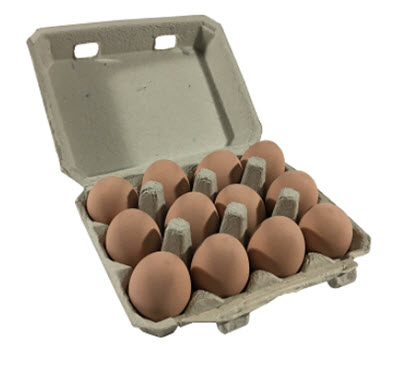We humans love to eat eggs and we want to eat them even if we happen to live far away from the farm. Before the egg carton was invented, eggs could easily get cracked as they were transported from the farm to the market, or from the market to the home of the buyer. Accidents were common place, hence the age-old caution against “putting all your eggs in one basket”.
Shape
 The basic shape of the egg carton haven’t changed much since it was invented over a century ago. An egg carton is specially designed for storing and transporting whole eggs and there is one dimple for each egg. An egg carton intended for a dozen eggs will thus have twelve dimples in which to put the eggs. The egg carton doesn’t just shield the eggs from the outside world; it also shields each individual egg from coming into contact with any of the other eggs.
The basic shape of the egg carton haven’t changed much since it was invented over a century ago. An egg carton is specially designed for storing and transporting whole eggs and there is one dimple for each egg. An egg carton intended for a dozen eggs will thus have twelve dimples in which to put the eggs. The egg carton doesn’t just shield the eggs from the outside world; it also shields each individual egg from coming into contact with any of the other eggs.
Some egg cartons only have dimples at the bottom part. Others have corresponding dimples in the bottom part and the lid part.
If there is no lid, the term egg tray is commonly used instead of egg carton.
Materials
Traditionally, egg cartons consisted of moulded pulp, typically made from recycled newsprint. More recently, other variants has entered the market, such as egg cartons made from expanded polystyrene (similar to Styrofoam) and egg cartons made from polyethylene terephthalate (PET).
Sizes
Egg cartons come in a variety of sizes, reflecting consumer needs for various amount of eggs. Some of the most commonly available sizes are for half a dozen eggs, a dozen eggs, 15 eggs, 18 eggs and 20 eggs.
Containers for more than 20 eggs are often egg trays rather than egg cartons.
The history of the egg carton
Thomas Peter Bethell, United Kingdom
In 1906, a predecessor to the modern egg carton was invented by Thomas Peter Bethell in Liverpool. Bethell’s product, which he marketed as the Raylite Egg Box, consisted of frames of interlocking strips of cardboard to hold the eggs. These frames were then themselves packed in cardboard or wooden boxes before the eggs could be transported.
Joseph Coyle, Smithers, USA
The egg carton was invented by newspaper editor Joseph Coyle in Smithers, British Columbia, in 1911.
Coyle started thinking about egg packaging after overhearing a dispute between a hotelier and someone who was delivering eggs to him in Aldermere (near present-day Telkwa). Eggs delivered to the hotel often arrived broken and this was of course not a good thing for anyone involved. As a publisher of the Interior News, Coyle had his office near the hotel, and this is how is happened to be able to overhear the heated conversation.
Coyle realised that cartons with individually cushioned slots would reduce the risk of damage to the egg shells. He started experimenting and making prototypes by hand, and soon came up with a solution that became so popular that he had to invent an machine that could produce the cartons more efficiently. This machine is today on display at the Royal BC Museum in British Columbia.
Coyle patented his egg carton in 1918 and before the next year was over he had sold his stake in the newspaper business and moved to Vancouver to focus on the egg carton venture. As demand grew, he would move to various other parts of North America to set up factories, including large cities such as Toronto, Los Angeles and Chicago.
In the late 1930s, Coyle moved back to British Columbia where he remained settled for the rest of his life – which was a long time because he lived for a hundred years. When he died in 1972, hundreds of millions of his cartons had been produced.
The egg carton was not Coyle’s only invention; he also invented an anti-theft device for vehicles and a pocket cigar cutter.
Morris Koppelman, USA
In 1921, a version of the egg carton was patented in the United States by Morris Koppelman, New York City.
https://www.google.com/patents/US1543443
United Industrial Syndicate, USA
In 1969, United Industrial Syndicate (UIS) in Maine received a patent for the egg carton. The three inventors listed on the filing were Walter H. Howarth, Gerald A. Snow and Harold A. Doughty.
UIS was a division of The Portland Company.
